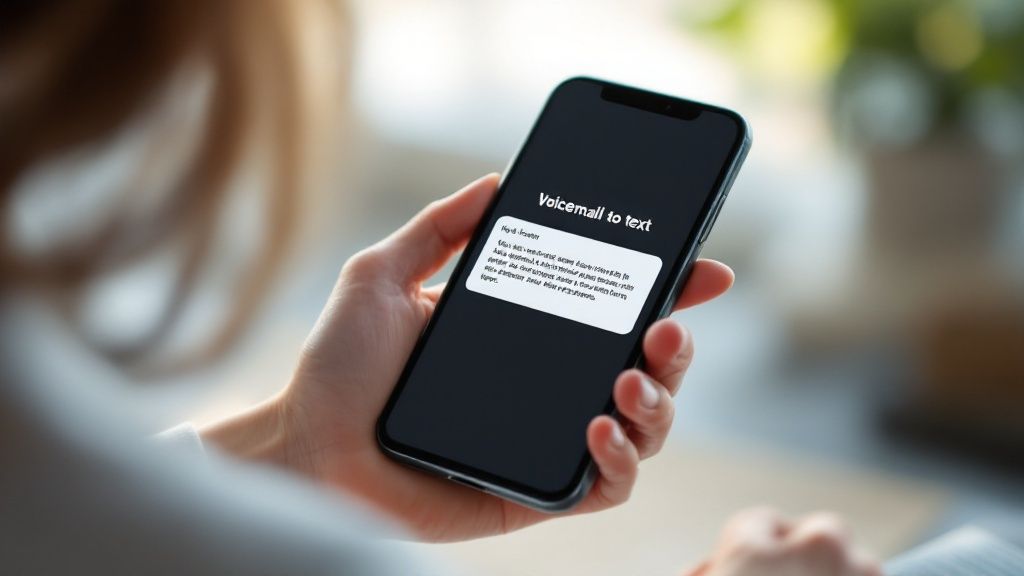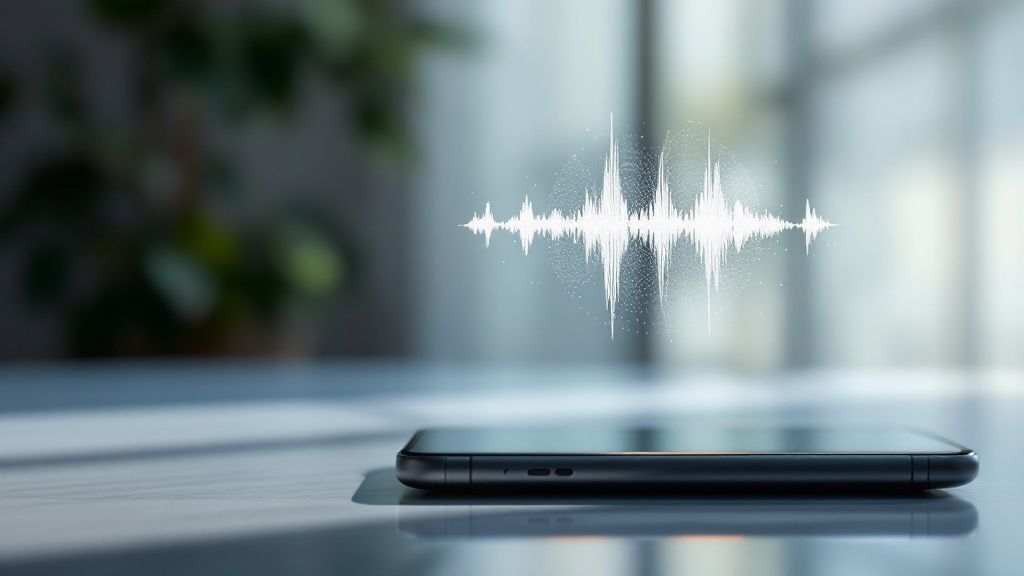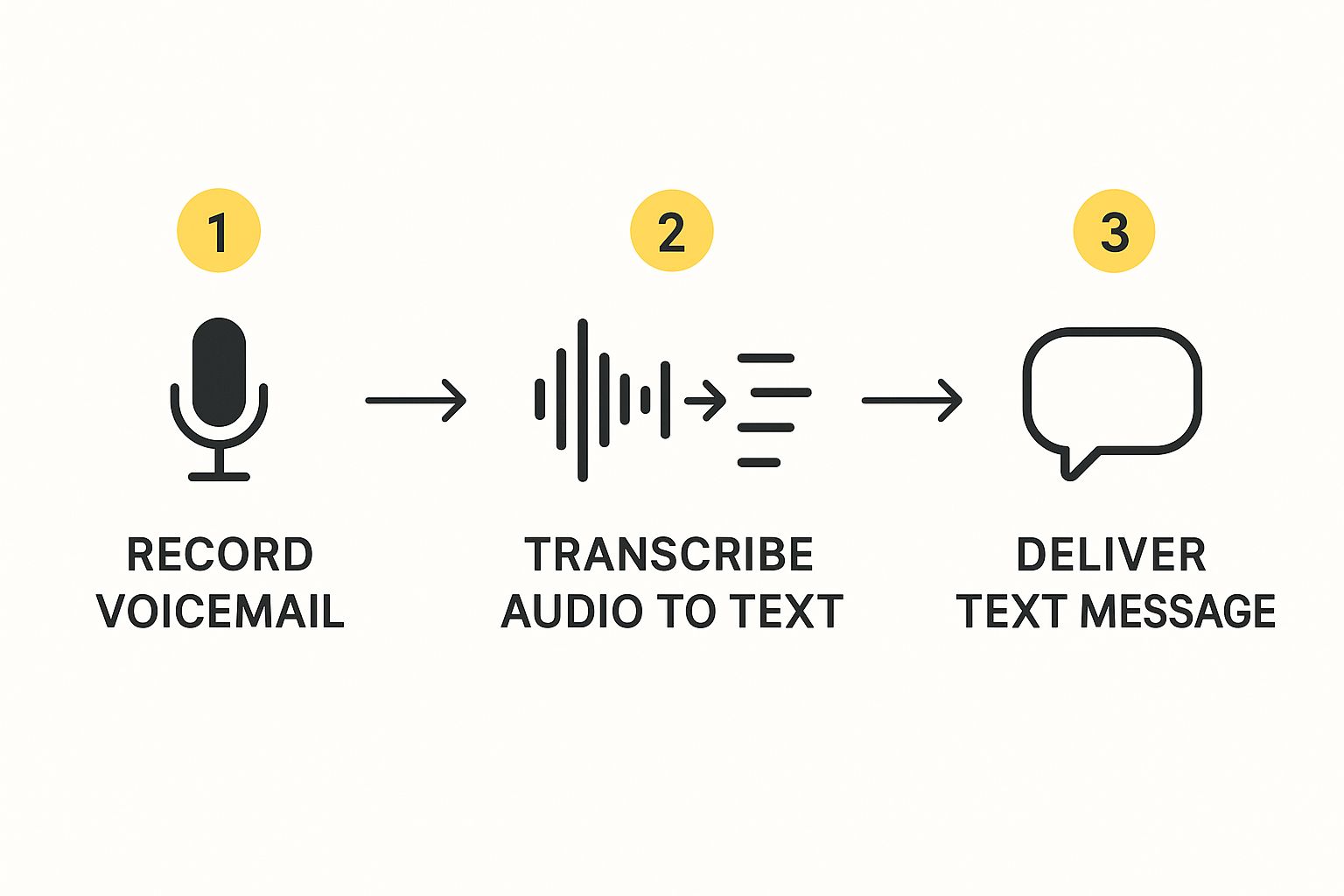Let's be real, who actually listens to voicemails anymore? It feels like a throwback to a different era. In a world of instant texts and quick messages, hitting pause on your day to figure out what a long, rambling voicemail is even about is a total productivity killer. This is where converting your voicemail to text comes in – it’s the essential upgrade that turns those inconvenient audio files into something you can actually scan and use.
Why Reading Voicemails is the New Norm
The move away from traditional voicemail isn't just a matter of taste; it’s a practical solution for our ridiculously busy lives. We've all been there: straining to hear a critical phone number on a noisy train or trying to discreetly check a message while you're in the middle of a meeting. Those moments perfectly capture why audio-only communication just doesn't cut it anymore.

It all comes down to a need for speed and efficiency. Think about these real-world scenarios:
- The contractor on a loud job site: Reading a client's message with a crucial measurement is a hundred times more reliable than replaying a crackly audio file three times over.
- The real estate agent dashing between viewings: A quick scan of a transcribed offer is far quicker than trying to find a quiet corner to listen to a two-minute message.
- The property manager juggling dozens of tenants: Searching a text for a specific address or maintenance issue is worlds easier than scrubbing through endless audio recordings.
This shift towards text lines up with bigger trends, too. In fact, more than half of Australian consumers have actually stopped dealing with a business because of poor communication, which really hammers home the need for better tools.
Voicemail to text isn't just some neat feature; it's an essential tool for getting your time back. It makes your communications faster, more private, and so much more organised. It lets you deal with things on your own terms.
When you make this switch, you're not just saving a few minutes; you're building a more resilient way to communicate. It's a massive part of asynchronous communication, which is all about responding thoughtfully without the pressure of being "on" all the time. Reading a message means you can absorb the info, think about your reply, and act when it actually suits you—not just when the phone happens to ring. It’s a simple change that transforms a frustrating interruption into just another manageable task in your workflow.
Finding The Right Voicemail Transcription Service

Deciding how to get your voicemails as text can feel like a big choice, but it really boils down to what you actually need. Are you a solo professional juggling client calls, a small business owner trying to track every lead, or just after a bit more personal convenience?
Your answer will point you down one of three main paths. You could stick with the built-in features on your smartphone, like Apple’s Visual Voicemail. Another route is to use services offered directly by Australian carriers like Telstra or Optus. And finally, there are dedicated third-party apps designed to offer a lot more grunt.
Comparing Your Options
Each of these approaches has its own pros and cons. Native phone features are handy but often pretty basic. Carrier services are well-integrated but can come with extra fees and limited functionality. A dedicated app is usually the most powerful choice, especially if you’re using it for business.
To make things a bit clearer, I’ve put together a quick comparison table. Think of it as a cheat sheet to help you weigh up the real-world factors like cost, accuracy, and the extra features that can make all the difference.
Comparing Voicemail to Text Options
| Method | Best For | Typical Cost | Key Advantage | Potential Drawback |
|---|---|---|---|---|
| Native Phone Features | Casual personal use and quickly scanning messages. | Usually free (included with your plan). | Seamless integration with your phone's dialler. | Basic accuracy and no advanced features. |
| Carrier Services | Users who prefer to stay within their provider's ecosystem. | Varies; often a monthly add-on fee. | Simple setup directly through your carrier. | Can be costly for what it offers; lacks customisation. |
| Third-Party Apps | Professionals and businesses needing high accuracy and workflow tools. | Subscription-based (monthly or annually). | Superior accuracy, search, and integrations. | Requires a separate app installation and setup. |
Making The Right Choice For Your Needs
Let's get practical. For a tradie who needs to quickly pull up a client’s address from a message they left last week, the search function in a third-party app is an absolute game-changer. In the same way, a property manager could benefit hugely from a service that automatically forwards messages from specific tenants straight to their email.
The best solution is one that fits into your existing workflow, not one that forces you to adapt. For most professionals, the flexibility and power of a dedicated service provide the highest return.
At the end of the day, while the built-in options are a decent starting point, they often fall short for anyone who relies on their phone for business. Exploring a dedicated voicemail to text service opens up a world of advanced management tools that can genuinely save you time and stop important details from slipping through the cracks. These specialised tools are built from the ground up to turn your voicemail inbox from a chore into an efficient part of your workday, helping you stay organised and on top of every message.
How To Set Up Voicemail To Text: A Practical Walkthrough
Alright, let's get down to brass tacks. Theory is one thing, but getting this feature up and running on your own phone is what really counts. I’ll walk you through setting it up using a third-party app, which, in my experience, gives you the most powerful features, especially if you're a professional. We'll cover everything from picking the right app to the final, crucial step: telling your phone where to send its missed calls.
The whole process is actually a lot simpler than it sounds. A voicemail gets left, the service transcribes it, and then it pops up on your phone as a simple text message.
This image breaks down exactly how a voicemail becomes a text you can read.

As you can see, the tech does all the heavy lifting in the background. For you, the experience is totally seamless.
Finding and Installing Your App
First things first, you'll need to head to your phone’s app marketplace. That’s the Apple App Store for iPhone users or the Google Play Store if you're on Android. Just search for "voicemail to text" or a specific app like OnSilent.
My advice? Look for an app with solid reviews, a clear privacy policy, and features that actually fit what you need, like being able to search for keywords or get your messages sent to your email.
Once you've picked one, just download and install it. The sign-up is usually pretty quick – just your name, email, and phone number to get your account sorted. This links the service to your mobile number, getting it ready to handle your voicemails.
Directing Your Missed Calls
Now for the most important part of the puzzle. It’s a feature called conditional call forwarding, and it's the key to making this whole thing work.
Basically, you’re telling your mobile network (whether you're with Telstra, Optus, or Vodafone) to send any missed or unanswered calls to your new voicemail service instead of its old, clunky default. If you skip this, your voicemails will just keep piling up in the same old place.
Think of it like setting up a mail redirection with Australia Post. You're just telling your mobile carrier to send your "unanswered call" packages to a new, smarter address.
To do this, you'll need to punch a specific code into your phone's dialler and hit call. Each Aussie carrier has slightly different codes, but the app you chose should provide them in its setup guide. For a really clear guide on this crucial step, you can learn exactly how to set up OnSilent on your phone to get the right codes and instructions.
Once that code is in, you’re all set. The next time you can't answer a call, it'll get rerouted to your new service, and you'll get a clean text transcription just moments later. It's a tiny change that makes a huge difference in managing your day.
Beyond Transcription: Advanced Management Tips
Getting your voicemails as neat text messages is a great first step, but honestly, you’ve only just scratched the surface. The real magic isn't just reading the messages; it's what you can do with them next. This is where you can turn a simple convenience into a serious productivity engine for your business.
Instead of just reacting to messages as they pop up, you need to think about building smart workflows around them. This moves you from being a passive recipient of messages to an active manager of your own communications.
Create Automated Workflows
Let’s get practical. Imagine you're a real estate agent. You could set up a rule so that any message containing the word "offer" or "inspection" is automatically forwarded to your email with a high-priority flag. Boom. No more digging.
Or, if you’re a tradie, you could have messages from your key suppliers sent directly to your team's Slack or Microsoft Teams channel. Simple automations like these ensure critical info always gets to the right place without you lifting a finger.
The goal is to build a system that sorts and prioritises your communications for you. This frees you up to focus on the work that actually matters, rather than getting bogged down in message admin.
Unlock The Power Of Search
One of the most underrated features of a solid voicemail-to-text service is having a fully searchable history of your messages.
Remember that client who called a few months back with a specific quote number? Instead of scrolling through an endless list of calls, you can just search for "quote" or their name and find the exact message in seconds. This turns your voicemails into an invaluable, searchable archive of all your client communications.
Here’s a look at how OnSilent organises your transcribed voicemails, making them dead simple to search and manage.

This kind of clean, organised layout turns what was once a messy, chaotic inbox into an actionable to-do list.
This shift towards text-based management fits perfectly with how we use our devices in Australia. With smartphone penetration expected to hit 89% by 2025, people are already wired to engage with text over traditional calls. You can dive deeper into these trends with these Australian SMS statistics on 160.com.au.
Even better, by integrating your service with a CRM, you can log client communications automatically, making sure your records are always up-to-date. This transforms your voicemail from a simple messaging tool into a core part of your business toolkit.
Getting Voicemail To Text to Play Nice: A Quick Troubleshooting Guide
Look, even the best tech has its moments, and voicemail-to-text is no different. It's incredibly frustrating when it decides to act up, but the good news is that most of the common gremlins are surprisingly easy to sort out yourself. Let's walk through the usual suspects and get you back on track.
Garbled or Just Plain Wrong Transcriptions?
One of the biggest grumbles we hear is about getting transcriptions that look like gibberish. Before you point the finger at the app, think about the source. Most of the time, the real culprit is just poor audio quality on the caller's end. Picture it: a client calling from a noisy construction site or driving with the windows down and the radio on full blast.
While you can't magically soundproof their end of the line, you can usually still listen to the original audio file that comes with the transcription. A quick listen is often all it takes to clear up what a muffled word or bit of background noise scrambled in the text.
When Your Messages Go Missing
The other classic headache is when your voicemail transcriptions are late to the party or don't show up at all. This almost always comes down to a problem with your call forwarding settings. It's sneaky, too—sometimes a phone software update or a change on your provider's network can reset these settings without you even realising it.
To fix it, you just need to re-enter the call forwarding codes for your mobile provider.
- Find the right code: First, make sure you're using the correct sequence for when your phone is busy or when a call goes unanswered.
- Dial it in: Punch that code into your phone's dialler, just like you're making a call, and hit the send button.
- Give it a test run: Get a mate to call you and let it ring out to voicemail. This will confirm the fix has worked and everything is routing correctly again.
Honestly, the most powerful troubleshooting tool is often the simplest. Just restarting your phone or re-entering those call forwarding codes can fix over 90% of connectivity issues. It forces your phone to get a fresh handshake with your carrier's network.
Think of it as a quick reset that reminds your phone of its instructions: "send my missed calls to the transcription service". Taking a minute to do this can save you a world of pain and make sure you never miss that next big job.
Got Questions About Voicemail to Text? We’ve Got Answers.
Making the switch to a voicemail to text service is a great move, but it's natural to have a few questions pop up. You want to be sure you're making the right call for your business. We get it.
Let's clear up some of the most common queries we hear.
Is My Data Secure and Private?
This is a big one, and rightly so. The short answer is: it depends on your provider.
If you’re using the built-in features from Apple or Google, or a service from a major carrier like Telstra, your data is generally kept secure within their ecosystem. For third-party apps like ours, look for ones that use strong encryption to protect your messages both when they're sent and when they're stored.
My best advice? Always have a quick read of the privacy policy. It’ll tell you exactly how your data is being handled and who has access to it, giving you peace of mind.
How Accurate Are the Transcriptions, Really?
Honestly, the technology has come a long way. Accuracy is surprisingly high these days, especially when the caller leaves a clear message. Most modern services can handle different accents and speaking styles without a problem, giving you text that captures all the important details.
Of course, some things can throw it off a bit. A really strong accent, someone speaking a million miles an hour, or a lot of background noise—like a call from a busy worksite—might lead to a few minor slip-ups in the text.
Can I Still Listen to the Original Voicemail?
Yes, absolutely. You don’t lose the original audio. Almost every voicemail to text service I've come across makes sure of it.
You’ll usually get a direct link or an audio file attached right there with the transcribed text. This is super handy if you want to catch the caller's tone of voice or just double-check a specific detail that didn't come through clearly in the text.
Ready to stop playing phone tag and start reading your messages? OnSilent turns your missed calls into texts you can act on, saving you a heap of time and keeping you organised. Find out how OnSilent can change the way you manage calls.

